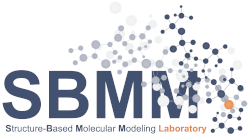Research
Development of new computational approaches to identify Membrane PAINS
We are currently developing a new computational approach with atomic detail, to identify membrane Pan-Assay Interference compoundS. These chemicals have been a major concern in Drug Discovery pipelines, since they can interfere with the activity results, and consequently have a major economic impact on such campaigns. Membrane PAINS, are a specific class of compounds known to impact membranes, and consequently mechanosensitive membrane protein’s function.
Identification of G4 stabilizers for the treatment of cancer
Quadruplexes (G4) are structural arrangements of DNA and RNA rich in guanine, with profound implications for various pharmacological and biological events, including cancers. The identification and development of ligands interacting with G4s have attracted great attention as potential anticancer therapies or in molecular probe applications. In this project, our objective is to develop new computational approaches to identify, develop and characterize selective DNA/RNA G4 ligands, that stabilize such structural arrangements, halting the replication of cancer cells.
Structural characterization of Aquaporins and identification of function modulators
Aquaporins (AQPs) are transmembrane proteins that facilitate the diffusion of water and glycerol across cell membranes, crucial for water and energy homeostasis. These proteins were found overexpressed in different cancer cells and tissues, being involved in tumor formation, cell proliferation, and migration, suggesting their great potential as drug targets for cancer treatment. In this project, our objective is to structurally characterize different AQP subtypes and identify and develop new functional modulators that could afterward be used as potential therapeutic agents in the fight against cancer.
DNA-binding proteins as potential targets for treatment and diagnosis of African swine fever
African swine fever virus (ASFV) is a large-enveloped DNA-containing virus that infects domestic and wild pigs, and multiplies in soft ticks, causing an economically relevant hemorrhagic disease. In this project, we aim to structurally characterize several proteins involved in the replication of this virus, which ultimately can be used in the development of new diagnostic or treatment approaches against this impacting disease.
Characterization of post-translational modifications in metabolic enzymes
Post-translational modifications (PTMs) of mitochondrial enzymes are major modifiers of the metabolism. Protein PTMs result from the enzymatic or nonenzymatic attachment of specific groups to amino acid side chains, consequently influencing both protein’s structure and cellular functions. Despite the currently available animal/cellular models, the molecular mechanisms underlying these regulatory functions, which are likely critical in disease states, remain to be elucidated. In this project, we aim to clarify this issue with a multidisciplinary approach combining in vitro and in silico methods to study the effects of protein acylation on a critical mitochondrial enzyme, electron transfer flavoprotein (ETF).
Development of machine learning approaches to the identification of Endocrine Disruptors
Endocrine disruptors, sometimes also referred to as hormonally active agents, endocrine-disrupting chemicals, or endocrine-disrupting compounds are chemicals that can interfere with endocrine (or hormonal) systems. These disruptions can cause cancerous tumors, birth defects, and other developmental disorders. This situation led to a request from several regulatory European agencies for a guidance document for implementing the hazard-based criteria to identify EDs. The development of new in silico methods capable of identifying such compounds is of utmost importance to pharmaceutical, chemical and agrochemical industries. Therefore, the objective of this project is to combine ligand and structure-based approaches with machine-learning methods for identifying EDs.
